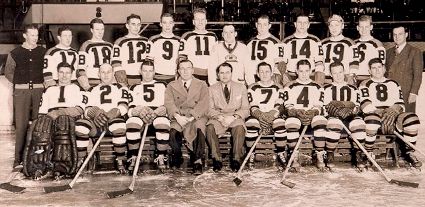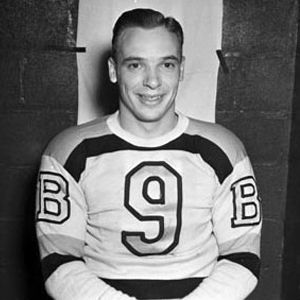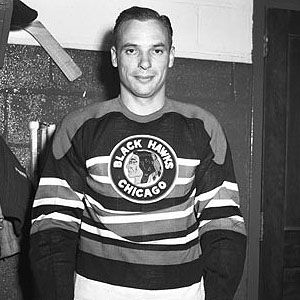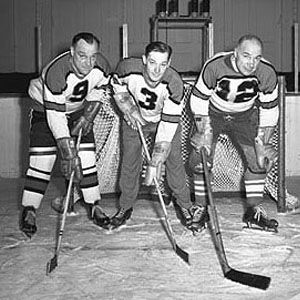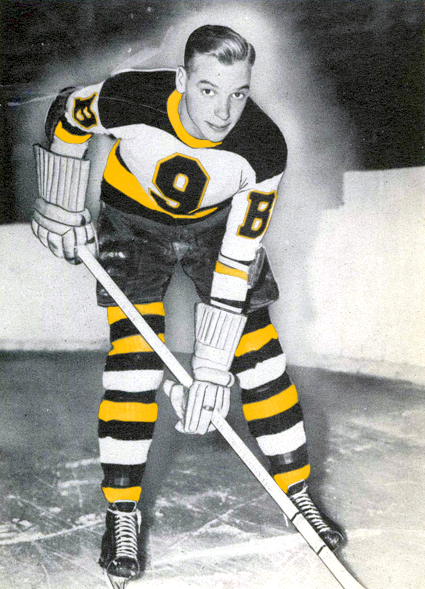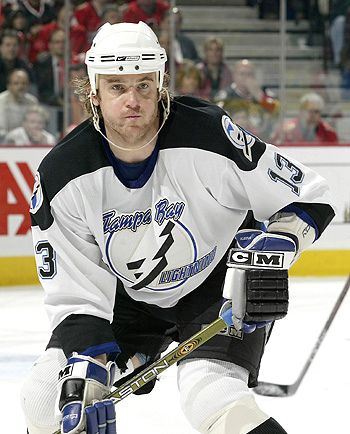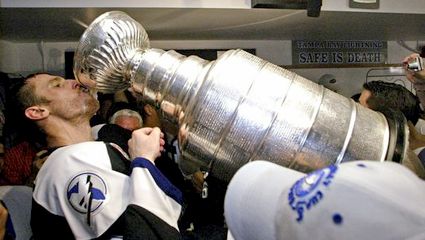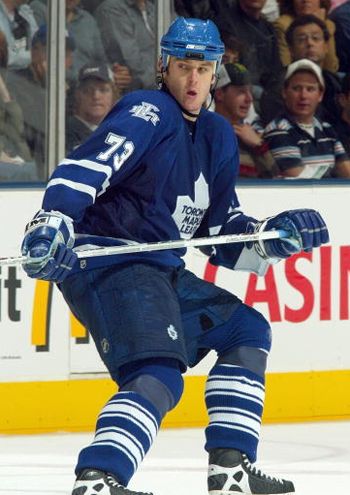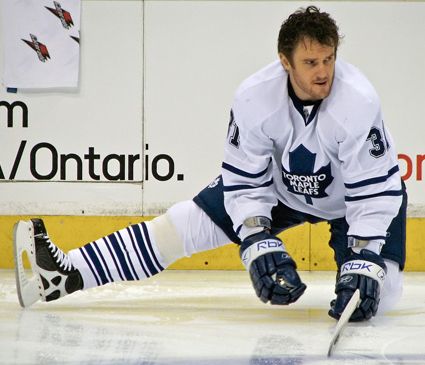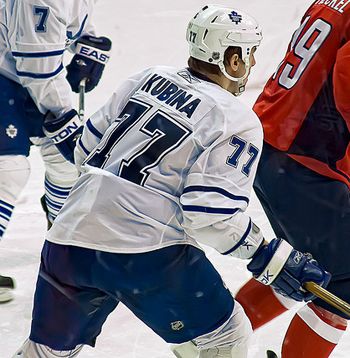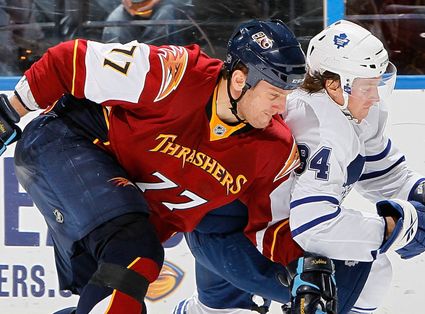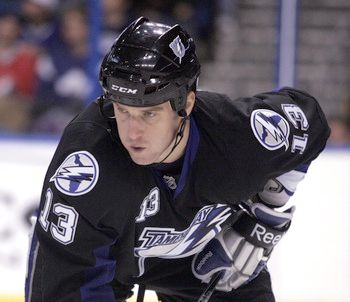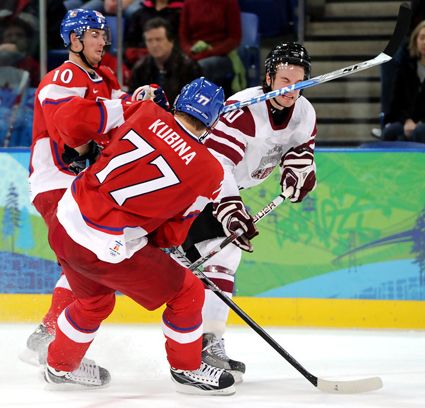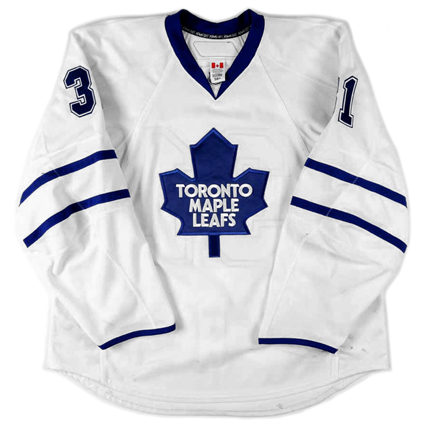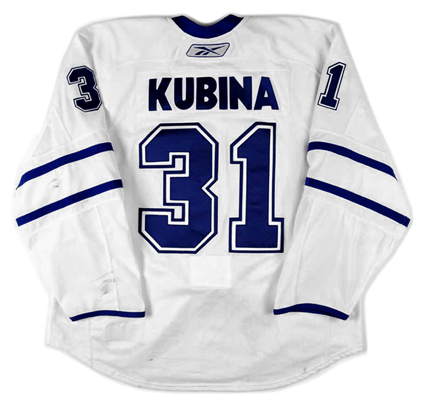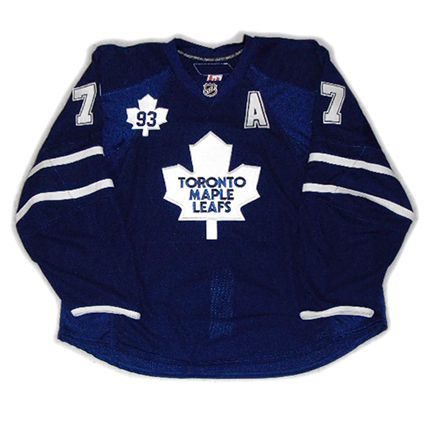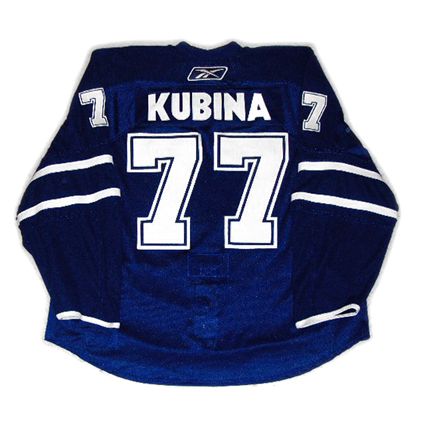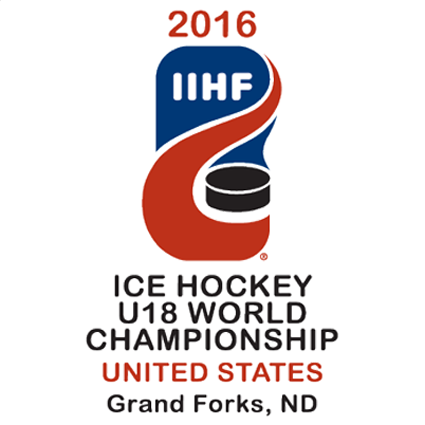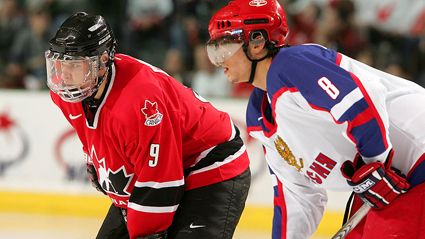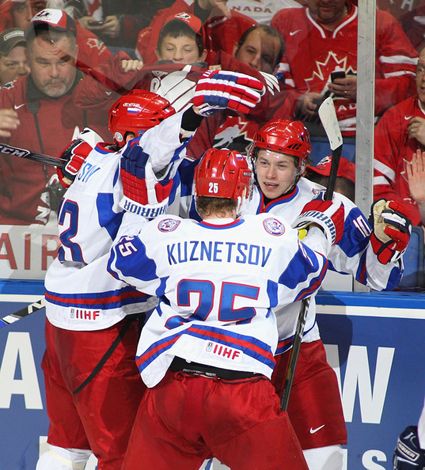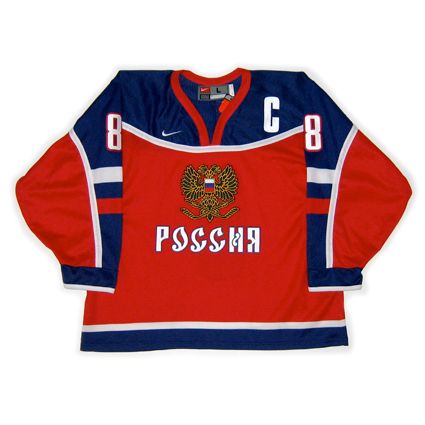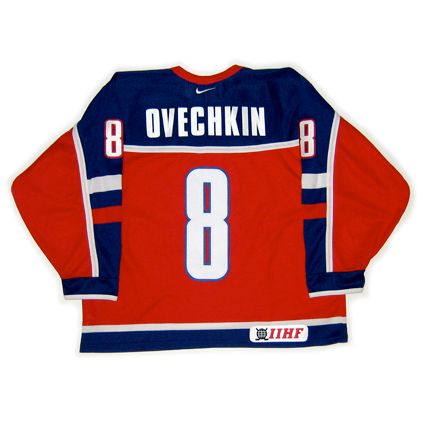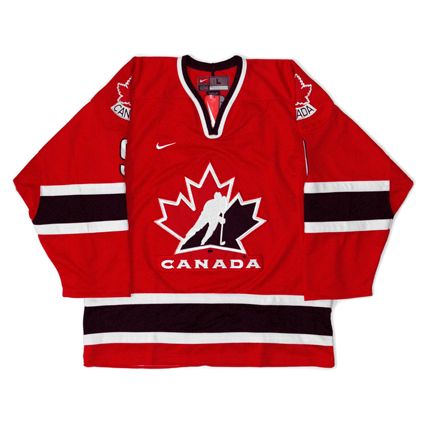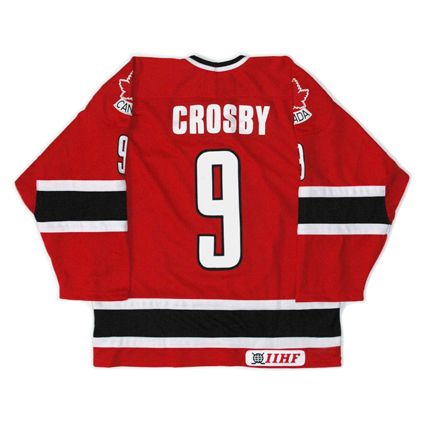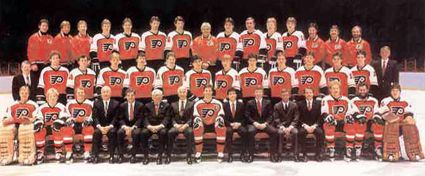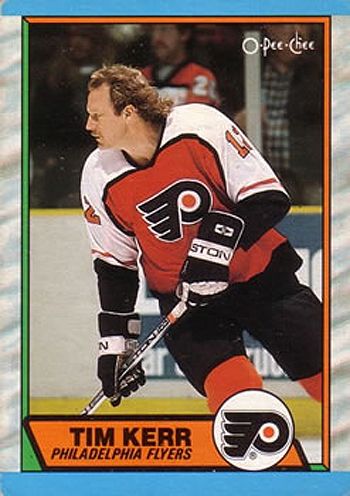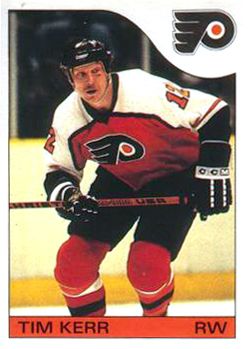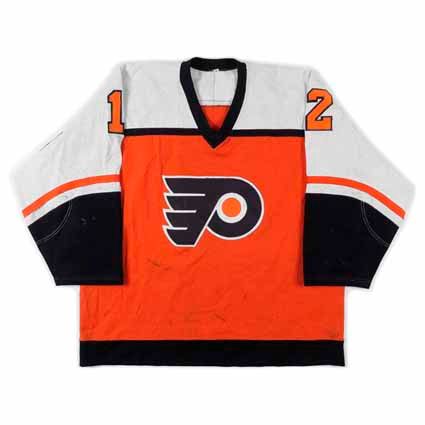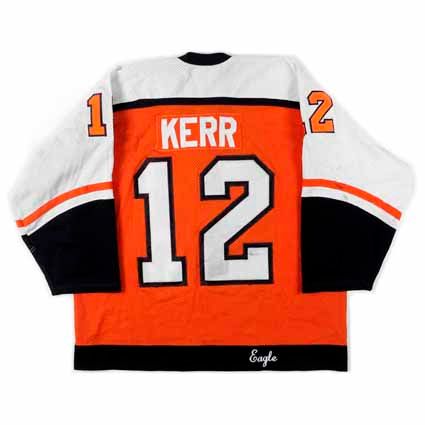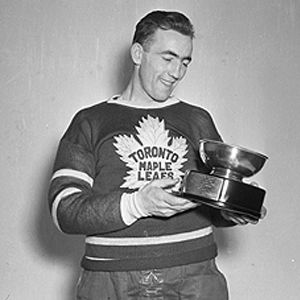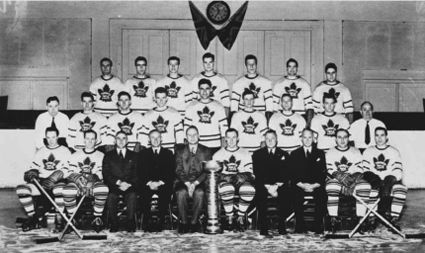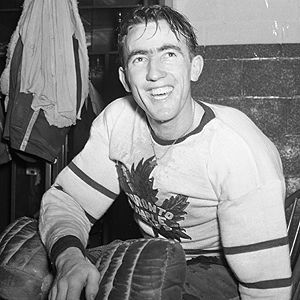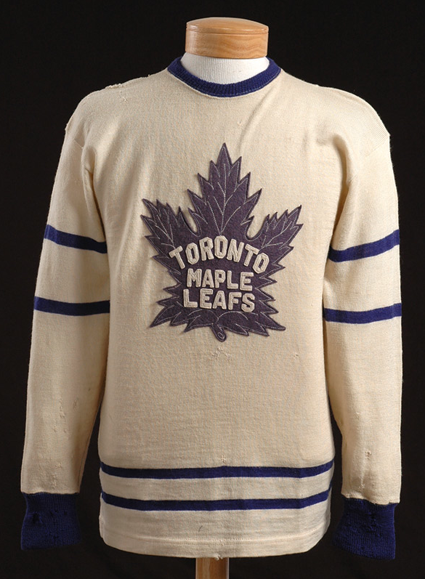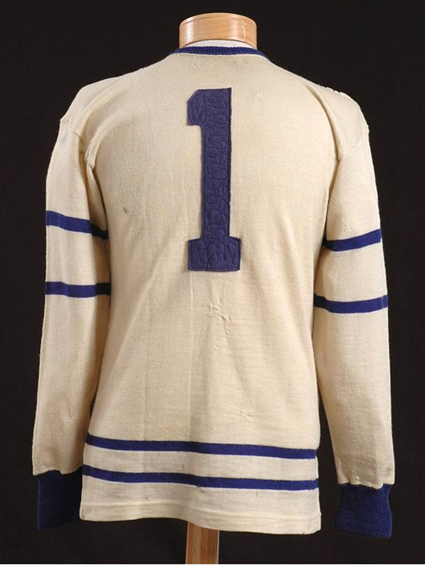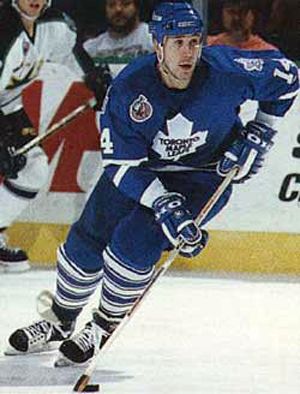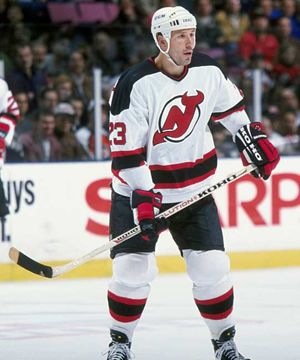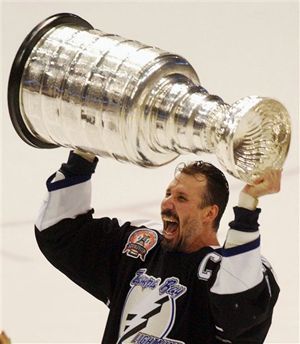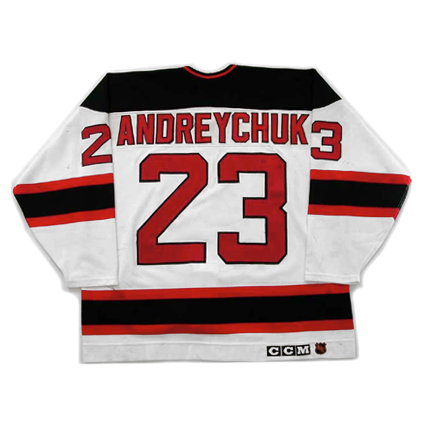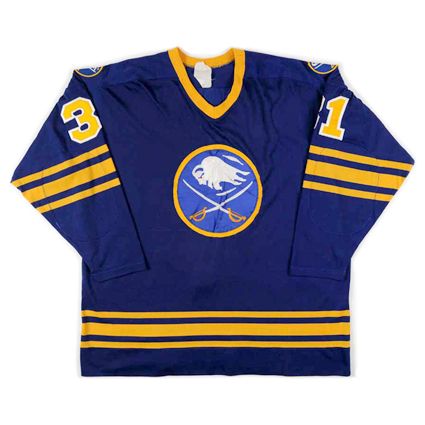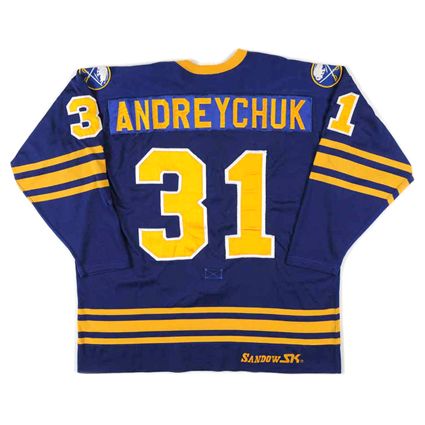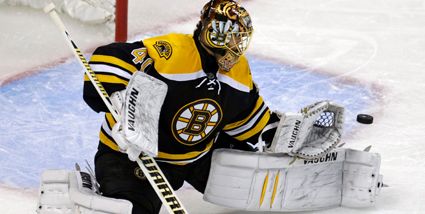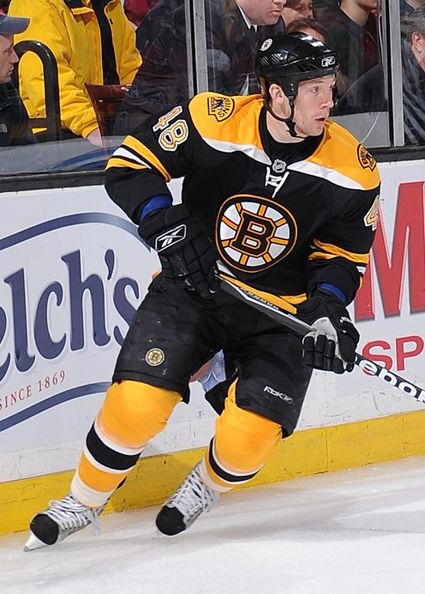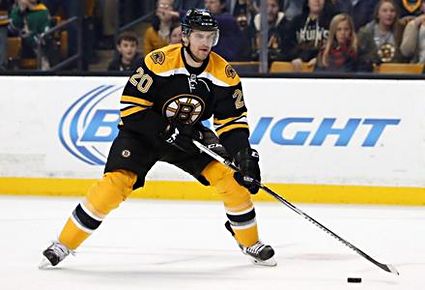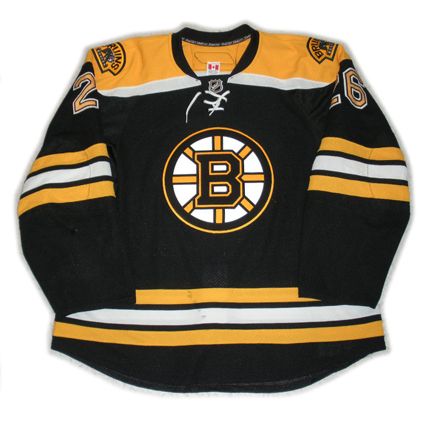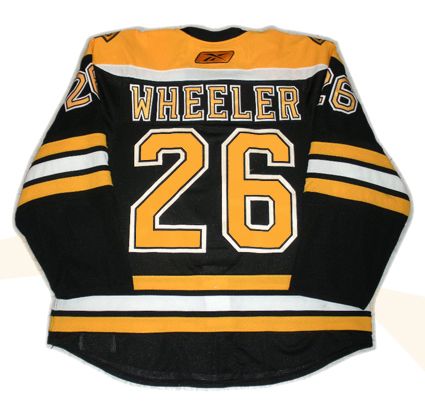Saturday, April 16, 2016
1938-39 Boston Bruins Roy Conacher Jersey
Beginning his career with the West Toronto Nationals of the Ontario Hockey Association in 1933-34, Roy Conacher and the Nationals would capture the Memorial Cup in 1936. Conacher would then join the Toronto Dominos in senior hockey in 1936-37 before joining the Kirkland Lake Hargreaves for 1937-38, where he had a fine season, scoring 12 goals and 23 points in 14 games.
Roy Conacher while with the Dominoes
That fine season led to him making his NHL debut the following season of 1938-39 with the Boston Bruins, where he established himself with a league leading 26 goals and 37 points in 47 games, good for second on he club behind only linemate and future Hall of Famer Bill Cowley as the Bruins finished atop the NHL standings with a 36-10-2 record for 74 points, 16 ahead of the second place New York Rangers. Conacher was the last rookie to lead the league in goals until Teemu Selanne 54 years later!
During the odd playoff format of the era, Boston immediately faced the Rangers in a best-of-seven series for an immediate berth in the Stanley Cup Finals, while the second and third place teams faced off with the winner meeting the survivor of the fourth place vs. fifth place club, all best-of-three series.
Boston won the first game against the Rangers in New York after 59:25 of overtime, just 35 second short of two complete games, setting the tone for what would be a most difficult series for both clubs.
Boston won another overtime game at home in Game 2 after 8:24 of extra time before a relatively easy 4-1 win in Game 3. The series moved back to New York, where the Rangers won a narrow 2-1 win. Back in Boston for Game 5, the Rangers won another 2-1 game, this one requiring 17:19 of overtime.
The Rangers then evened the series at 3-3 after having lost the first three games when they took a 3-1 win in New York, setting up a Game 7 in Boston.
In yet another 2-1 game, the fourth of the series and fifth one goal game, Boston survived after 48 minutes of overtime, the fourth game to extend beyond regulation time.
The Toronto Maple Leafs advanced to face the Bruins in the finals after defeating the New York Americans and the Detroit Red Wings, which they accomplished so quickly that they had an extras day's rest despite having to play in two series spread out over three cities. In fact, Toronto had played in just five games with an additional 5 minutes of overtime, while the Bruins needed seven games plus an additional 133 minutes of overtime, the equivalent of over two additional games of play!
The 1939 Stanley Cup Finals began in Boston on April 6th, a game won by Bobby Bauer of Boston with a goal with 4 1/2 minutes remaining for a 1-0 series lead. Game 2 on the 9th went to the visiting Maple Leafs in overtime before the series moved to Toronto for Game 3 on April 11th.
There was no scoring through the first two periods before Bauer got Boston on the board at 1:28 followed by Conacher at 8:12. Jack Crawford extended the Bruins lead to 3-0 and when Gus Marker got one by Frank Brimsek with just 49 seconds remaining to spoil the shutout, it made Conacher's goal the game winner.
Boston went up 3 games to 1 when Brimsek shut out the Maple Leafs as Conacher scored both Bruins goals, the first coming at 2:21 of the first period on the powerplay, which gave him his second game winning goal in as many games. His second goal came at 12:55 of the third period to give the Bruins some additional breathing room.
It was back to Boston for Game 5 and the Bruins broke out on top with Mel Hill's goal from Conacher and Cowley at 11:40 with a man advantage only to have Toronto even the score at 18:40 of the first with Bingo Kampman's goal at 18:40.
The only goal of the second period was by Conacher, from Cowley and Eddie Shore at 17:54. Brimsek then held the Maple Leafs at bay throughout the third period while Flash Hollett added a late goal with just 37 seconds left in the game to make the final margin 3-1 as the Bruins captured the Stanley Cup thanks to the rookie Conacher's third consecutive game winning goal on this date in 1939, making him the first player to ever score three straight game winning goals in one playoff series, let alone the finals.
The 1939 Stanley Cup champion Boston Bruins
Conacher finished second in playoff scoring for the Bruins with 6 goals and 4 assists for 10 points, trailing only Cowley's 3 goals and 11 assists.
Conacher would go on to play three more seasons for the Bruins, including winning a second Stanley Cup in 1941 before his career was interrupted like so many others by World War II from 1942-43 to 1944-45, during which time he did compete for a number of Royal Canadian Air Force teams on a limited basis.
Roy during his later years with the Bruins
He returned to the NHL with the Bruins for 4 regular season and 3 playoff games in 1945-46 before being traded to Detroit for 1946-47 when the Bruins' Art Ross had his doubts that Conacher could regain his previous form. In his only season in Detroit, Conacher posted the only 30 goal season of his career on his way to 54 points in 60 games while becoming the answer to a trivia question, as he wore #9 with Detroit during Gordie Howe's rookie season as Howe wore #17. During that season Conacher had a career best four goals in a single game, all of them assisted by Billy Taylor, who set an NHL record with 7 assists that night.
After just one season with Detroit, following a dispute over his pay, Conacher was traded to the Chicago Black Hawks where he would play the final five seasons of his career, reeling off consistent seasons of 22, 26, 25 and 26 goals before an abbreviated final season in 1951-52.
Roy while with the Chicago Black Hawks
He would finish his career with 490 games played, 226 goals and 200 assists for 426 points and a pair of Stanley Cups and an Art Ross Trophy, won in 1949 while with Chicago when he totaled a career best 68 points in 60 games while teamed with playmakers Bill Mosienko and Doug Bentley, ironically winning a trophy for scoring excellence named after the very same man who doubted his!
Roy was inducted into the Hockey Hall of Fame in 1998, joining his older brothers Charlie (1961) and Lionel (1994) as the only trio of brothers currently in the Hall of Fame.
Hall of Famers Charlie and Lionel Conacher flanking Roy's twin brother Bert
Today's featured jersey is a 1938-39 Boston Bruins Roy Conacher jersey as worn by the rookie Conacher when he scored the game winning goal in three consecutive games to lead the Bruins to the Stanley Cup.
The Bruins debuted this sweater style in 1936-37 before the term "sports marketing" had been invented, choosing to feature a large player number on the front of their jerseys instead of any sort of logo in what looked more like an NFL football jersey.
The numbers would reverse colors in 1940-41 and would remain that way until the 1948-49 season when the famous "spoked B" would be seen for the first time.
Today's video segment is an interesting look at what hockey was like back in 1939 when Conacher was a rookie.
Labels:
Boston Bruins,
Conacher Roy
Friday, April 15, 2016
2007-08 Toronto Maple Leafs Pavel Kubina Jersey
After beginning his career with HC Viktovice of the Czech Extraliga, during which time he was drafted by the Tampa Bay Lightning during the 1996 NHL Entry Draft, Pavel Kubina made the move to North America for the following season when he joined the Moose Jaw Warriors of the Western Hockey League, where he impressed with 44 points in 61 games while adapting to a new culture.
The 1997-98 season saw defenseman Kubina spend the majority of his time with the Adirondack Red Wings of the American Hockey League, playing in 55 games, but also making his NHL debut with the Lightning, playing in a total of 10 games that season, which included scoring his first NHL goal.
The following season Kubina saw his final games in the minors, playing in six contests for the Cleveland Lumberjacks of the International Hockey League, but the majority of the season was spent establishing himself as an NHL regular with 68 games and 21 points for Tampa Bay.
Kubina would spend the next six seasons with the Lighting patrolling the blueline, averaging 75 games played and 29 points a season, which was highlighted by being a member of Tampa Bay's Stanley Cup championship season of 2003-04. Kubina would contribute 4 points during the 22 playoff games in the Lightning's run to the cup.
During the NHL lockout of 2004-05, Kubina did what many European natives chose to do, and he returned to the club where he got his start, HC Viktovice. Unlike most NHLers though, Kubina did not return to the NHL once the season resumed in January of 2005 and stayed with Viktovice.
He did return to the Lighting for the 2005-06 season, picking up where he left off with a then career high 38 points in 75 games.
After eight seasons with Tampa Bay, Kubina singed a free agent contract with the Toronto Maple Leafs for the 2006-07 season. Kubina had been wearing #13 while playing for the Lightning, but found that number occupied by no less than the Maple Leafs team captain Mats Sundin. Unable to wear his preferred #13, Kubina chose to go with #73, since the mainly vertical #7 was the most visibly similar to the #1.
After a slow start to his Maple Leafs career, which included games lost due to injuries, Kubina decided that #73 wasn't really quite right for him and chose to change to #31 in December of 2006, which was #13 with the digits reversed.
When Kubina began wearing #31, he became the first non-goaltender to wear #31 for Toronto in their then 81 year history. In a classy move on his part, Kubina offered to pay for anyone who had already purchased a Maple Leafs jersey with his #73 to have it converted to a #31 out of his own pocket!
After Kubina competed the remainder of the 2006-07 season and all of the 2007-08 season with #31, including setting a career high with 40 points in 2007-08, the Maple Leafs re-signed their former goaltender Curtis Joseph to a free agent contract for the upcoming 2008-09 season.
Joseph had been the Maple Leafs #1 goalkeeper from 1998-99 through the 2001-02 season before leaving for the Detroit Red Wings. After five seasons away from Toronto, Joseph, now in the later phase of his career, signed with the Maple Leafs in a backup role to Vesa Toskala. Kubina, showing a great sense of history and class, relinquished the #31 to Joseph, who had worn it all throughout his now 19 year NHL career.
Kubina then elected to go with yet a new number, this time #77, likely due to the fact he was born on this date in 1977, similar to the number change undergone by teammate Nik Antropov, who himself swapped #11 for #80 for the year of his birth 1980, during the 2002-03 season.
The change to #77 had no ill effects for Kubiina, who not only matched his career best 40 points from the season prior, but he also set a new career high in goals scored with 14.
Kubina's time in Toronto came to an end when he was dealt to the Atlanta Thrashers for the 2009-10 season, where he one more produced his steady output of 38 points in 76 games while sticking with the #77 in Atlanta as he arrived to find Slava Kozlov having already claimed #13 and Ondrej Pavelec wearing #31.
After his only season in Atlanta, Kubina returned to Tampa Bay as a free agent where he was finally able to reclaim his #13 after four seasons away from the Lightning. Kubina would play all of the 2010-11 season and 52 games of the 2011-12 season with Tampa Bay before a late season trade sent him to the Philadelphia Flyers for the final 17 games of the season.
With the NHL players again locked out at the start of the 2010-13 season, Kubina planned on returning to familiar ground and signed with HC Vikovice for his third stint with the Czech club, only he was still subject to a 15 game ban he incurred back in 2005 when last playing for Viktovice after they lost a playoff series in which they were leading 3 games to 1. Kubina called the referee of the deciding game that went against them "a corrupt bastard" and accused him of taking a bribe! His comments not only earned him a ban, but also a 7,000 Euro fine and a lawsuit for slander, which set him back another 14,000 Euros.
Kubina did manage to find some playing time in Europe this season, signing with Geneve Servette of the Swiss National League A in mid February, apparently declining several offers to return to the NHL. He would play just three regular season games and one playoff game with the club, which were the final of his playing career.
Internationally, Kubina has been a regular on the Czech Republic national team, dating back to the 1996 World Junior Championships. He joined the senior team at the World Championships in 1999, coming away with a gold medal on his first try while scoring 8 points in 12 games. His second World Championship gold came in 2001 and a busy 2002 saw him make his Olympic debut in February, followed by his third World Championships later that spring.
He completed a hat trick of World Championship gold in 2005 and added another medal to his collection with a bronze at the 2006 Olympics. His final international competition was the 2010 Olympics in Vancouver.
His final NHL career totals were 970 games played with 110 goals and 386 points, a Stanley Cup and three World Championship gold medals and an Olympic bronze on his resume.
Today's featured jersey is a 2007-08 Toronto Maple Leafs Pavel Kubina jersey from Kubina's second season as #31 and the first for the new Reebok Edge jerseys. These jerseys lack the usual waist stripes of the Maple Leafs jerseys of the previous 13 seasons reportedly due to Reebok's original intent that their new generation of jerseys would be tucked into the player's pants, eliminating the need for any waist striping.
When the jerseys were eventually worn untucked as always, the waist striping returned in 2008-09 on the club's new alternate jersey and in 2010-11 when the home and road styles were tweaked.
Bonus jersey: Today's bonus jersey is a 2008-09 Toronto Maple Leafs Pavel Kubina jersey as worn on January 31, 2009 when the Maple Leafs celebrated former team captain Doug Gilmour's #93 by raising it to the rafters where it joined the ranks of Maple Leafs honored numbers.
Today's video section begins with a brief, but hard hitting tribute to Kubina highlighting his time with the Maple Leafs.
This next video focuses on Kubina's time with Tampa Bay.
Finally, the Fastest Announcer in the World narrates highlights of Kubina's first gold medal with the Czech Republic at the 1999 World Championships. There is even an interview with Kubina in his native Czech, and he's apparently trying to talk as fast as the announcer!
The 1997-98 season saw defenseman Kubina spend the majority of his time with the Adirondack Red Wings of the American Hockey League, playing in 55 games, but also making his NHL debut with the Lightning, playing in a total of 10 games that season, which included scoring his first NHL goal.
The following season Kubina saw his final games in the minors, playing in six contests for the Cleveland Lumberjacks of the International Hockey League, but the majority of the season was spent establishing himself as an NHL regular with 68 games and 21 points for Tampa Bay.
Kubina would spend the next six seasons with the Lighting patrolling the blueline, averaging 75 games played and 29 points a season, which was highlighted by being a member of Tampa Bay's Stanley Cup championship season of 2003-04. Kubina would contribute 4 points during the 22 playoff games in the Lightning's run to the cup.
During the NHL lockout of 2004-05, Kubina did what many European natives chose to do, and he returned to the club where he got his start, HC Viktovice. Unlike most NHLers though, Kubina did not return to the NHL once the season resumed in January of 2005 and stayed with Viktovice.
He did return to the Lighting for the 2005-06 season, picking up where he left off with a then career high 38 points in 75 games.
After eight seasons with Tampa Bay, Kubina singed a free agent contract with the Toronto Maple Leafs for the 2006-07 season. Kubina had been wearing #13 while playing for the Lightning, but found that number occupied by no less than the Maple Leafs team captain Mats Sundin. Unable to wear his preferred #13, Kubina chose to go with #73, since the mainly vertical #7 was the most visibly similar to the #1.
The rare sight of Kubina wearing #73
After a slow start to his Maple Leafs career, which included games lost due to injuries, Kubina decided that #73 wasn't really quite right for him and chose to change to #31 in December of 2006, which was #13 with the digits reversed.
Kubina sporting his new #31
When Kubina began wearing #31, he became the first non-goaltender to wear #31 for Toronto in their then 81 year history. In a classy move on his part, Kubina offered to pay for anyone who had already purchased a Maple Leafs jersey with his #73 to have it converted to a #31 out of his own pocket!
After Kubina competed the remainder of the 2006-07 season and all of the 2007-08 season with #31, including setting a career high with 40 points in 2007-08, the Maple Leafs re-signed their former goaltender Curtis Joseph to a free agent contract for the upcoming 2008-09 season.
Joseph had been the Maple Leafs #1 goalkeeper from 1998-99 through the 2001-02 season before leaving for the Detroit Red Wings. After five seasons away from Toronto, Joseph, now in the later phase of his career, signed with the Maple Leafs in a backup role to Vesa Toskala. Kubina, showing a great sense of history and class, relinquished the #31 to Joseph, who had worn it all throughout his now 19 year NHL career.
Kubina then elected to go with yet a new number, this time #77, likely due to the fact he was born on this date in 1977, similar to the number change undergone by teammate Nik Antropov, who himself swapped #11 for #80 for the year of his birth 1980, during the 2002-03 season.
Kubina took #77 in recognition of Curtis Joseph's long career
The change to #77 had no ill effects for Kubiina, who not only matched his career best 40 points from the season prior, but he also set a new career high in goals scored with 14.
Kubina's time in Toronto came to an end when he was dealt to the Atlanta Thrashers for the 2009-10 season, where he one more produced his steady output of 38 points in 76 games while sticking with the #77 in Atlanta as he arrived to find Slava Kozlov having already claimed #13 and Ondrej Pavelec wearing #31.
After his only season in Atlanta, Kubina returned to Tampa Bay as a free agent where he was finally able to reclaim his #13 after four seasons away from the Lightning. Kubina would play all of the 2010-11 season and 52 games of the 2011-12 season with Tampa Bay before a late season trade sent him to the Philadelphia Flyers for the final 17 games of the season.
With the NHL players again locked out at the start of the 2010-13 season, Kubina planned on returning to familiar ground and signed with HC Vikovice for his third stint with the Czech club, only he was still subject to a 15 game ban he incurred back in 2005 when last playing for Viktovice after they lost a playoff series in which they were leading 3 games to 1. Kubina called the referee of the deciding game that went against them "a corrupt bastard" and accused him of taking a bribe! His comments not only earned him a ban, but also a 7,000 Euro fine and a lawsuit for slander, which set him back another 14,000 Euros.
Kubina did manage to find some playing time in Europe this season, signing with Geneve Servette of the Swiss National League A in mid February, apparently declining several offers to return to the NHL. He would play just three regular season games and one playoff game with the club, which were the final of his playing career.
Internationally, Kubina has been a regular on the Czech Republic national team, dating back to the 1996 World Junior Championships. He joined the senior team at the World Championships in 1999, coming away with a gold medal on his first try while scoring 8 points in 12 games. His second World Championship gold came in 2001 and a busy 2002 saw him make his Olympic debut in February, followed by his third World Championships later that spring.
Kubina on his way to gold at the 2005 World Championships
He completed a hat trick of World Championship gold in 2005 and added another medal to his collection with a bronze at the 2006 Olympics. His final international competition was the 2010 Olympics in Vancouver.
Kubina later in his career, wearing #77 at the 2010 Olympics
His final NHL career totals were 970 games played with 110 goals and 386 points, a Stanley Cup and three World Championship gold medals and an Olympic bronze on his resume.
Today's featured jersey is a 2007-08 Toronto Maple Leafs Pavel Kubina jersey from Kubina's second season as #31 and the first for the new Reebok Edge jerseys. These jerseys lack the usual waist stripes of the Maple Leafs jerseys of the previous 13 seasons reportedly due to Reebok's original intent that their new generation of jerseys would be tucked into the player's pants, eliminating the need for any waist striping.
When the jerseys were eventually worn untucked as always, the waist striping returned in 2008-09 on the club's new alternate jersey and in 2010-11 when the home and road styles were tweaked.
Bonus jersey: Today's bonus jersey is a 2008-09 Toronto Maple Leafs Pavel Kubina jersey as worn on January 31, 2009 when the Maple Leafs celebrated former team captain Doug Gilmour's #93 by raising it to the rafters where it joined the ranks of Maple Leafs honored numbers.
Today's video section begins with a brief, but hard hitting tribute to Kubina highlighting his time with the Maple Leafs.
This next video focuses on Kubina's time with Tampa Bay.
Finally, the Fastest Announcer in the World narrates highlights of Kubina's first gold medal with the Czech Republic at the 1999 World Championships. There is even an interview with Kubina in his native Czech, and he's apparently trying to talk as fast as the announcer!
Labels:
Kubina Pavel,
Toronto Maple Leafs
Thursday, April 14, 2016
The 2016 IIHF U18 World Championships
Today marks the beginning of the 2016 IIHF U18 World Championships in Grand Forks, North Dakota at the Ralph Englestad Arena, home of the NCAA national champion University of North Dakota Fighting Hawks.
"The Ralph" is no stranger to hosting international tournaments, having previously hosted the 2005 World Juniors, which featured a bumper crop of up and coming talent due to the NHL season being cancelled that year, which freed up several players who would have otherwise been employed in a normally active NHL. The most recognizable names from that tournament included Dion Phaneuf, Shea Weber, Jeff Carter, Sidney Crosby, Ryan Getzlaf, Mike Richards, Corey Perry and Patrice Bergeron of Canada, David Krejci and Michael Frolik of the Czech Republic, Tukka Rask of Finland, Thomas Greiss of Germany, Alexander Ovechkin and Evgeni Malkin of Russia and Ryan Callahan, Phil Kessel, Drew Stafford, Alex Goligoski, Ryan Suter, Al Montoya and Cory Schneider of the United States.
The U18 World Championships began in 1999 and the first two years were won by Finland. Subequently, the tournament has been won by Russia in 2001 and 2007, Canada in 2008, 2003 and 2013 and by the United States nine times, including six of the last seven years including the previous two tournaments in 2014 and 2015.
The United States run of six out of the last seven began in 2009, the only previous time the tournament was held in the United States, 80 miles down the road from this year's location in Grand Forks when it was held in Fargo, North Dakota and Moorhead, Minnesota. To give you an idea of the potential talent one might see at this year's edition, the 2009 event included future NHLers Ryan O'Reilly of Canada, Mikael Granlund and Erik Haula of Finland, Tom Kühnhackl of Germany, Evgeni Kuznetsov, Alexander Burmistrov and Vladimir Tarasenko of Russia, Nino Niederreiter and Sven Bartschi of Switzlerand, Robin Lehner, Oliver Ekman-Larsson, Gabriel Landeskog, Magnus Pääjärvi-Svensson of Sweden and Americans Jack Campbell, Cam Fowler and Jason Zucker.
This year's U18 tournament sees ten teams competing in two groups of five each. Group A consists of Latvia, Russia, Sweden, Switzerland and the United States. Group B contains Canada, the Czech Republic, Denmark, Finland and Slovakia.
The first game today is a Group A matchup between Latvia and Switzerland and is a vital match for each club in their efforts to reach the playoff round and avoid the fight for relegation. The same can be said for the second game of the day, a Group B match between Slovakia and Denmark. After the Czech Republic and Finland take to the ice at the tournament's secondary arena, the Icon Sports Center (also in Grand Forks), the day's main event begins at 7:30 when the United States begins it's defense of it's gold medal against no less than Russia.
Canada begins play Friday against Denmark and Sweden takes the ice for the first time versus Latvia.
From there, the US plays both Saturday against Sweden and on Sunday they take on Latvia and Canada's second game comes on Saturday when they battle the Czech Republic. The Preliminary Round concludes with four games on Monday and the last four of the round on Tuesday, highlighted by Sweden vs. Russia and Finland vs. Canada as well as the final game for the Americans against the Swiss.
At the conclusion of the Preliminary Round, the top four nations in each group will be paired with a team from the opposite group in the Quarterfinals on April 21st, with the group winners facing the #4 team from the other, while the #2's take on the opposite #3's. After a day off, the Semifinals will be on April 23rd with the Bronze and Gold Medal games being on Sunday, April 24th.
Meanwhile, the two fifth place teams in each group will meet in a best-of-three series to determine which team will be relegated down to Division I Group A for 2017.
The NHL Network in the US will be broadcasting all of the games of the United States, some live and some later the same day while Canadian games can be found on TSN in Canada.
Many of the players in this tournament are highly ranked in advance of the upcoming NHL Draft in June. Center Logan Brown is ranked as the 7th prospect in the NHL Draft Prospect Rankings, while Clayton Keller is currently the leading scorer on the United States National Development Program team with 37 points in 23 games and is ranked 8th. The feisty Kieffer Bellows, son of former NHLer Brian Bellows is next at 10th. Center Trent Frederic and defensemen Ryan Lindgren and Adam Fox round out the top 50 at 47, 49 and 50.
Canada's roster includes Jakob Chychrun, who will likely be the first defenseman taken this year and is ranked at an eye opening #4 among North American skaters. Canada has an embarrassment of riches at center, with Michael McLeod at #13, Tyson Jost #16, Pascal Laberge #28, Jordan Kyrou #34 and William Bitten at #42. Additionally, defenseman Dante Fabbro at #18 and right wing Cameron Morrison at #46 are both also in the top 50.
Sweden's Alexander Nylander, son of former NHLer Michael Nylander, is a left winger to keep an eye on, currently ranked #3 has already led Sweden in scoring at this year's U20 World Juniors and will be a force on the ice at the U18's.
The most notable among the Russians is defenseman Mikhail Sergachyov and his is projected to be a top ten pick this year and is ranked at #8 among North American skaters, as he is currently playing for the Windsor Spitfires of the OHL.
No preview of this tournament would truly be complete without mentioning the situation with the Russian squad, as the day before the U18 team was to leave for North America, the entire roster was recalled and replaced by the Russian U17 team over concerns of the recently banned drug Meldonium, the same substance that led to a failed test for tennis superstar Maria Sharapova. U18 head coach Vitaly Prokhorov was also fired by the Russian Minister of Sport and will not be there with the U17 replacement roster.
Accounts state that the majority of the U18 roster failed tests for Meldonium and the team is not being sent to avoid being tested in competition and subsequently suspended. With notice having been given that Meldonium would be banned as of January 1, 2016, Russian athletes reportedly discontinued its use last fall, but no one is currently sure how long it will stay in your system, but it looks as though it lingers long enough to have tripped up the Russian U18 squad, costing fans in Grand Forks the opportunity to see German Rubtsov, a center rated #6 among European skaters.
Meldonium apparently has been treated similar to a supplement in Russia to protect the heart during competition following the premature death of Alexei Cherepanov. However, it also has been classified as a metabolic modulator that can allow blood to carry more oxygen and aid in recovery times, and thus be considered a performance enhancing drug.
The question we have is, if there has been a long standing, systematic use of Meldonium by Russian athletes in ski jumping, tennis, ice hockey, volleyball, judo and even curling, why isn't the U17 team at the same risk for being tested in competition like the U18 squad? Hopefully the tournament in Grand Forks is allowed to play itself out naturally and this is the end of the discussion of Meldonium, doping, performance enhancing and drug testing and the competition stays out on the ice and not in the lab, either during or after the tournament.
"The Ralph" is no stranger to hosting international tournaments, having previously hosted the 2005 World Juniors, which featured a bumper crop of up and coming talent due to the NHL season being cancelled that year, which freed up several players who would have otherwise been employed in a normally active NHL. The most recognizable names from that tournament included Dion Phaneuf, Shea Weber, Jeff Carter, Sidney Crosby, Ryan Getzlaf, Mike Richards, Corey Perry and Patrice Bergeron of Canada, David Krejci and Michael Frolik of the Czech Republic, Tukka Rask of Finland, Thomas Greiss of Germany, Alexander Ovechkin and Evgeni Malkin of Russia and Ryan Callahan, Phil Kessel, Drew Stafford, Alex Goligoski, Ryan Suter, Al Montoya and Cory Schneider of the United States.
2005 World Juniors at Ralph Englestad Arena
The U18 World Championships began in 1999 and the first two years were won by Finland. Subequently, the tournament has been won by Russia in 2001 and 2007, Canada in 2008, 2003 and 2013 and by the United States nine times, including six of the last seven years including the previous two tournaments in 2014 and 2015.
The United States run of six out of the last seven began in 2009, the only previous time the tournament was held in the United States, 80 miles down the road from this year's location in Grand Forks when it was held in Fargo, North Dakota and Moorhead, Minnesota. To give you an idea of the potential talent one might see at this year's edition, the 2009 event included future NHLers Ryan O'Reilly of Canada, Mikael Granlund and Erik Haula of Finland, Tom Kühnhackl of Germany, Evgeni Kuznetsov, Alexander Burmistrov and Vladimir Tarasenko of Russia, Nino Niederreiter and Sven Bartschi of Switzlerand, Robin Lehner, Oliver Ekman-Larsson, Gabriel Landeskog, Magnus Pääjärvi-Svensson of Sweden and Americans Jack Campbell, Cam Fowler and Jason Zucker.
Evgeni Kuznetsov and Vladimir Tarasenko competed at the last
U18 World Championship in the United States in 2009,
which was held in Fargo, North Dakota
This year's U18 tournament sees ten teams competing in two groups of five each. Group A consists of Latvia, Russia, Sweden, Switzerland and the United States. Group B contains Canada, the Czech Republic, Denmark, Finland and Slovakia.
The first game today is a Group A matchup between Latvia and Switzerland and is a vital match for each club in their efforts to reach the playoff round and avoid the fight for relegation. The same can be said for the second game of the day, a Group B match between Slovakia and Denmark. After the Czech Republic and Finland take to the ice at the tournament's secondary arena, the Icon Sports Center (also in Grand Forks), the day's main event begins at 7:30 when the United States begins it's defense of it's gold medal against no less than Russia.
Canada begins play Friday against Denmark and Sweden takes the ice for the first time versus Latvia.
From there, the US plays both Saturday against Sweden and on Sunday they take on Latvia and Canada's second game comes on Saturday when they battle the Czech Republic. The Preliminary Round concludes with four games on Monday and the last four of the round on Tuesday, highlighted by Sweden vs. Russia and Finland vs. Canada as well as the final game for the Americans against the Swiss.
At the conclusion of the Preliminary Round, the top four nations in each group will be paired with a team from the opposite group in the Quarterfinals on April 21st, with the group winners facing the #4 team from the other, while the #2's take on the opposite #3's. After a day off, the Semifinals will be on April 23rd with the Bronze and Gold Medal games being on Sunday, April 24th.
Meanwhile, the two fifth place teams in each group will meet in a best-of-three series to determine which team will be relegated down to Division I Group A for 2017.
The NHL Network in the US will be broadcasting all of the games of the United States, some live and some later the same day while Canadian games can be found on TSN in Canada.
Many of the players in this tournament are highly ranked in advance of the upcoming NHL Draft in June. Center Logan Brown is ranked as the 7th prospect in the NHL Draft Prospect Rankings, while Clayton Keller is currently the leading scorer on the United States National Development Program team with 37 points in 23 games and is ranked 8th. The feisty Kieffer Bellows, son of former NHLer Brian Bellows is next at 10th. Center Trent Frederic and defensemen Ryan Lindgren and Adam Fox round out the top 50 at 47, 49 and 50.
Canada's roster includes Jakob Chychrun, who will likely be the first defenseman taken this year and is ranked at an eye opening #4 among North American skaters. Canada has an embarrassment of riches at center, with Michael McLeod at #13, Tyson Jost #16, Pascal Laberge #28, Jordan Kyrou #34 and William Bitten at #42. Additionally, defenseman Dante Fabbro at #18 and right wing Cameron Morrison at #46 are both also in the top 50.
Sweden's Alexander Nylander, son of former NHLer Michael Nylander, is a left winger to keep an eye on, currently ranked #3 has already led Sweden in scoring at this year's U20 World Juniors and will be a force on the ice at the U18's.
The most notable among the Russians is defenseman Mikhail Sergachyov and his is projected to be a top ten pick this year and is ranked at #8 among North American skaters, as he is currently playing for the Windsor Spitfires of the OHL.
No preview of this tournament would truly be complete without mentioning the situation with the Russian squad, as the day before the U18 team was to leave for North America, the entire roster was recalled and replaced by the Russian U17 team over concerns of the recently banned drug Meldonium, the same substance that led to a failed test for tennis superstar Maria Sharapova. U18 head coach Vitaly Prokhorov was also fired by the Russian Minister of Sport and will not be there with the U17 replacement roster.
Accounts state that the majority of the U18 roster failed tests for Meldonium and the team is not being sent to avoid being tested in competition and subsequently suspended. With notice having been given that Meldonium would be banned as of January 1, 2016, Russian athletes reportedly discontinued its use last fall, but no one is currently sure how long it will stay in your system, but it looks as though it lingers long enough to have tripped up the Russian U18 squad, costing fans in Grand Forks the opportunity to see German Rubtsov, a center rated #6 among European skaters.
Meldonium apparently has been treated similar to a supplement in Russia to protect the heart during competition following the premature death of Alexei Cherepanov. However, it also has been classified as a metabolic modulator that can allow blood to carry more oxygen and aid in recovery times, and thus be considered a performance enhancing drug.
The question we have is, if there has been a long standing, systematic use of Meldonium by Russian athletes in ski jumping, tennis, ice hockey, volleyball, judo and even curling, why isn't the U17 team at the same risk for being tested in competition like the U18 squad? Hopefully the tournament in Grand Forks is allowed to play itself out naturally and this is the end of the discussion of Meldonium, doping, performance enhancing and drug testing and the competition stays out on the ice and not in the lab, either during or after the tournament.
Today's featured jersey is a 2005 Russia National Team Alexander Ovechkin jersey.
as worn during the 2005 World Juniors, which was held in Grand Forks, North Dakota. Ovechkin was the captain of Russia at the 2005 World Juniors and his
jersey sports the captains "C" as well as the original International Ice
Hockey Federation logo patch on the lower back of the jersey as worn
by all the players in the tournament with the exception of the United
States 1932 throwback jerseys.
Ovechkin
would finish the tournament third in scoring with 11 points from 7
goals and 4 assists in 6 games, leading Russia to the gold medal game,
but was forced out of the contest with a shoulder injury that would keep
him out of action for Moscow Dynamo for two months following the
tournament.
Bonus jersey: Today's bonus jersey is a 2005 Canada National Team Sidney Crosby jersey
as worn during the 2005 World Junior Championships. His actual game
worn jersey was stolen following the tournament by an Air Canada baggage
handler in Montreal. It was later recovered in a mailbox in Quebec.
Labels:
IIHF
Wednesday, April 13, 2016
1984-85 Philadelphia Flyers Tim Kerr Jersey
The Philadelphia Flyers won the President's Trophy in 1984-85 with a record of 53-20-7 for 113 points, four ahead of the Edmonton Oilers at 109.
The Flyers were led in scoring that season by right winger Tim Kerr's 54 goals and 98 points, just ahead of Brian Propp with 43 goals and 96 points. Kerr was sixth in goals in the NHL that season, one back of Quebec's Michel Goulet and John Ogrodnick of Detroit who tied for fourth with 55 goals each.
The Flyers open the playoffs that season against the New York Rangers, who were paired in a best of five opening round series. Game 1 saw the Flyers jump out to a 3-0 first period lead at home at The Spectrum only to have the Rangers score two in the second period and tie the game at 3-3 with a goal 1:17 into the third period. Kerr then give the Flyers back the lead at 6:04. With victory in sight, Anders Hedberg tied the game with just 26 seconds remaining to send the game into overtime. After 8:01 of overtime, Mark Howe won the game from Grant Ledyard and Rick Tocchet.
Game 2 was tied at 1-1 after two periods before the Flyers pulled away with two goals in the third period win 3-1 and take a 2-0 series lead, putting the Rangers backs up against the wall.
Game 3 in Madison Square Garden was an offensive slugfest. New York drew first blood with a goal at 12:36 of the first period followed by a second power play goal at 16:41. Peter Zezel countered for Philadelphia with another power play goal 45 seconds later.
There were six goals scored in the second period alone, beginning with Doug Crossman's for the Flyers to tie the game at 6:25. Willie Huber put the Rangers back in front at 9:08 on the power play with Kerr in the box for Philadelphia for a 3-2 lead for New York.
With the Flyers now on the power play, Zezel, below the goal line in the right corner, fired a quick pass to Kerr who, left virtually unguarded, slammed the puck past Rangers goalie Glen Hanlon at 10:06. Kerr then struck again from Murray Craven at 14:58 to put the Flyers back on top 4-3 when he snapped a shot from the right faceoff circle past Hanlon.
Then, 1:44 later, Kerr completed his natural hat trick from Zezel and Howe with Philadelphia up a man on a play that was a mirror image of the first goal, with Zezel again feeding Kerr from below the goal line, only this time from the left corner, with Kerr converting the pass from the top of the goal crease on his backhand.
Kerr, however, was not finished as he then scored his fourth consecutive goal, and his third on the power play, at 18:22 when, trailing the play, he skated up the slot and took a feed from Zezel again and fired the puck past a shellshocked Hanlon. Zezel was credited with the first assist on goals 1, 3 and 4 during Kerr's outburst.
Kerr's four goals came within 8:16 of each other and set a record for Most Goals in One Period of a Playoff Game, Fastest Four Goals in a Playoff Game, Most Power Play Goals in a Period of a Playoff Game, and with the last three taking only 3:24, he also set a record for the Fastest Three Goals in a Playoff Game.
Kerr's four goals gave the Flyers a 6-3 lead going into the third period. Still not willing to go away quietly, the Rangers scored twice in the first four minutes of the third period against Philadelphia goaltender Pelle Lindbergh, who finished the game with 27 saves on 32 shots as Lindbergh and the Flyers held off New York for the final 16 minutes to complete the three game sweep and end the Rangers season.
In their next series against the New York Islanders, Kerr scored one goal in a 3-0 Flyers win in Game 1, added a second in Game 2, a 5-2 Philadelphia victory. He was held scoreless in a 5-3 Flyers win in Game 3. In Game 4 the Islanders staved off elimination by moving out to a 5-0 lead before Kerr scored twice late to make the final score 6-2 before the Flyers closed out the series with a 1-0 win in Game 5. By eliminating the Islanders, Philadelphia advanced to the Stanley Cup Finals to face the defending cup champion Edmonton Oilers.
Kerr scored once in the Flyers 4-1 opening game win and then again at the midpoint of Game 2 to tie the game at 1-1, but from then on the Oilers pulled away to win the game as well as the series to claim their second consecutive Stanley Cup. Kerr would lead the Flyers with 10 goals during the 1985 playoffs and was second in overall scoring with 14 points after Propp's 18.
Kerr played his junior hockey with the Kingston Canadiens of the Ontario Major Junior Hockey League from 1977-78 to 1979-80, a season during which he scored 40 goals and 73 points in 63 games. He was signed by the Flyers as an undrafted free agent. After playing seven games for the Maine Mariners of the AHL, Kerr began a 11 season run with the Flyers, highlighted by four consecutive 50 goal seasons from 1983-84 through 1986-87, scoring 54 the first two seasons and 58 the last two. His highest career point total came in 1984-85 when he added 44 assists to his 54 goals for a 98 point season.
A shoulder injury during the 1987 playoffs led to five surgeries over the next 14 months and cost him essentially the entire 1987-88 season, as he was only able to play 8 total games. He rebounded with a 48 goal, 88 point campaign the following year and then went on to score 14 goals and 25 points in 19 games of the 1989 playoffs. His return to the game after enduring the difficulties with his shoulder earned him the Bill Masterton Trophy for perseverance and dedication to hockey.
Kerr only played 40 games the following season and just 27 the season after that. He was left unprotected in the 1991 Expansion Draft and selected by the San Jose Sharks, who then traded him to the Rangers, where he managed 32 games in 1991-92. His career finished with 22 games with the Hartford Whalers in 1992-93 before he retired with 370 goals and 674 points in 655 games, leading the Flyers in scoring in 1983-84, 1984-85, 1986-87 and during his rebound season of 1988-89. At the time of his retirement, Kerr was 10th all-time in goals per game.
His outstanding game on this date in 1985 when he scored four goals during the second period set four separate records:
Today's featured jersey is a 1984-85 Philadelphia Flyers Tim Kerr jersey as worn when Kerr four league records during his four goal outburst during the second period of the Flyers playoff game on this date in 1985.
The Flyers had worn essentially the same jersey since their inception in 1967-68, with stripes that run down the arms until the wrap around the arms when they reach the black cuffs. Over time the numbers changed from one color to two, names were added to the back and black trim separated the body color from the shoulder/sleeve stripe starting in 1982-83 and the design received its final adjustments in 1983-84. A black alternate of the same design arrived in 1997-98 and became the primary road jersey in 2001-02 when the orange jersey was retired. The white and black jerseys would continue through the 2006-07 season until the introduction of the Reebok Edge jerseys brought their long run to an end.
The Flyers brought back an early version of today's orange jersey in 2008-09 as a throwback styled third jersey and made a white version for their appearance in the 2010 NHL Winter Classic and then made the white jersey their full time road jersey and their throwback orange alternate their new home jersey for the 2010-11 season and have worn them since.
In today's video section, Kerr's four goals in 8:16 of the second period of the Flyers playoff game against the Rangers on this date in 1985.
The Presidents' Trophy winning 1984-85 Philadelphia Flyers
The Flyers were led in scoring that season by right winger Tim Kerr's 54 goals and 98 points, just ahead of Brian Propp with 43 goals and 96 points. Kerr was sixth in goals in the NHL that season, one back of Quebec's Michel Goulet and John Ogrodnick of Detroit who tied for fourth with 55 goals each.
his career season of 1984-85
The Flyers open the playoffs that season against the New York Rangers, who were paired in a best of five opening round series. Game 1 saw the Flyers jump out to a 3-0 first period lead at home at The Spectrum only to have the Rangers score two in the second period and tie the game at 3-3 with a goal 1:17 into the third period. Kerr then give the Flyers back the lead at 6:04. With victory in sight, Anders Hedberg tied the game with just 26 seconds remaining to send the game into overtime. After 8:01 of overtime, Mark Howe won the game from Grant Ledyard and Rick Tocchet.
Game 2 was tied at 1-1 after two periods before the Flyers pulled away with two goals in the third period win 3-1 and take a 2-0 series lead, putting the Rangers backs up against the wall.
Game 3 in Madison Square Garden was an offensive slugfest. New York drew first blood with a goal at 12:36 of the first period followed by a second power play goal at 16:41. Peter Zezel countered for Philadelphia with another power play goal 45 seconds later.
There were six goals scored in the second period alone, beginning with Doug Crossman's for the Flyers to tie the game at 6:25. Willie Huber put the Rangers back in front at 9:08 on the power play with Kerr in the box for Philadelphia for a 3-2 lead for New York.
With the Flyers now on the power play, Zezel, below the goal line in the right corner, fired a quick pass to Kerr who, left virtually unguarded, slammed the puck past Rangers goalie Glen Hanlon at 10:06. Kerr then struck again from Murray Craven at 14:58 to put the Flyers back on top 4-3 when he snapped a shot from the right faceoff circle past Hanlon.
Then, 1:44 later, Kerr completed his natural hat trick from Zezel and Howe with Philadelphia up a man on a play that was a mirror image of the first goal, with Zezel again feeding Kerr from below the goal line, only this time from the left corner, with Kerr converting the pass from the top of the goal crease on his backhand.
Kerr, however, was not finished as he then scored his fourth consecutive goal, and his third on the power play, at 18:22 when, trailing the play, he skated up the slot and took a feed from Zezel again and fired the puck past a shellshocked Hanlon. Zezel was credited with the first assist on goals 1, 3 and 4 during Kerr's outburst.
Kerr's four goals came within 8:16 of each other and set a record for Most Goals in One Period of a Playoff Game, Fastest Four Goals in a Playoff Game, Most Power Play Goals in a Period of a Playoff Game, and with the last three taking only 3:24, he also set a record for the Fastest Three Goals in a Playoff Game.
Less than nine minutes later, Kerr was a multiple NHL record holder
Kerr's four goals gave the Flyers a 6-3 lead going into the third period. Still not willing to go away quietly, the Rangers scored twice in the first four minutes of the third period against Philadelphia goaltender Pelle Lindbergh, who finished the game with 27 saves on 32 shots as Lindbergh and the Flyers held off New York for the final 16 minutes to complete the three game sweep and end the Rangers season.
In their next series against the New York Islanders, Kerr scored one goal in a 3-0 Flyers win in Game 1, added a second in Game 2, a 5-2 Philadelphia victory. He was held scoreless in a 5-3 Flyers win in Game 3. In Game 4 the Islanders staved off elimination by moving out to a 5-0 lead before Kerr scored twice late to make the final score 6-2 before the Flyers closed out the series with a 1-0 win in Game 5. By eliminating the Islanders, Philadelphia advanced to the Stanley Cup Finals to face the defending cup champion Edmonton Oilers.
Kerr scored once in the Flyers 4-1 opening game win and then again at the midpoint of Game 2 to tie the game at 1-1, but from then on the Oilers pulled away to win the game as well as the series to claim their second consecutive Stanley Cup. Kerr would lead the Flyers with 10 goals during the 1985 playoffs and was second in overall scoring with 14 points after Propp's 18.
Kerr played his junior hockey with the Kingston Canadiens of the Ontario Major Junior Hockey League from 1977-78 to 1979-80, a season during which he scored 40 goals and 73 points in 63 games. He was signed by the Flyers as an undrafted free agent. After playing seven games for the Maine Mariners of the AHL, Kerr began a 11 season run with the Flyers, highlighted by four consecutive 50 goal seasons from 1983-84 through 1986-87, scoring 54 the first two seasons and 58 the last two. His highest career point total came in 1984-85 when he added 44 assists to his 54 goals for a 98 point season.
A shoulder injury during the 1987 playoffs led to five surgeries over the next 14 months and cost him essentially the entire 1987-88 season, as he was only able to play 8 total games. He rebounded with a 48 goal, 88 point campaign the following year and then went on to score 14 goals and 25 points in 19 games of the 1989 playoffs. His return to the game after enduring the difficulties with his shoulder earned him the Bill Masterton Trophy for perseverance and dedication to hockey.
and recognized with the Masterton Trophy
Kerr only played 40 games the following season and just 27 the season after that. He was left unprotected in the 1991 Expansion Draft and selected by the San Jose Sharks, who then traded him to the Rangers, where he managed 32 games in 1991-92. His career finished with 22 games with the Hartford Whalers in 1992-93 before he retired with 370 goals and 674 points in 655 games, leading the Flyers in scoring in 1983-84, 1984-85, 1986-87 and during his rebound season of 1988-89. At the time of his retirement, Kerr was 10th all-time in goals per game.
His outstanding game on this date in 1985 when he scored four goals during the second period set four separate records:
- Most Goals in a Period in a Playoff Game with 4
- Fastest Four Goals in a Playoff Game at 8:16
- Most Power Play Goals in a Period in a Playoff Game with 3
- Fastest Three Goals in a Playoff Game at 3:24
Today's featured jersey is a 1984-85 Philadelphia Flyers Tim Kerr jersey as worn when Kerr four league records during his four goal outburst during the second period of the Flyers playoff game on this date in 1985.
The Flyers had worn essentially the same jersey since their inception in 1967-68, with stripes that run down the arms until the wrap around the arms when they reach the black cuffs. Over time the numbers changed from one color to two, names were added to the back and black trim separated the body color from the shoulder/sleeve stripe starting in 1982-83 and the design received its final adjustments in 1983-84. A black alternate of the same design arrived in 1997-98 and became the primary road jersey in 2001-02 when the orange jersey was retired. The white and black jerseys would continue through the 2006-07 season until the introduction of the Reebok Edge jerseys brought their long run to an end.
The Flyers brought back an early version of today's orange jersey in 2008-09 as a throwback styled third jersey and made a white version for their appearance in the 2010 NHL Winter Classic and then made the white jersey their full time road jersey and their throwback orange alternate their new home jersey for the 2010-11 season and have worn them since.
In today's video section, Kerr's four goals in 8:16 of the second period of the Flyers playoff game against the Rangers on this date in 1985.
Next, a half hour documentary on Kerr's shoulder separation and his Masterton Trophy comeback season.
Labels:
Kerr Tim,
Philadelphia Flyers
Tuesday, April 12, 2016
1944-45 Toronto Maple Leafs Frank McCool Jersey
Frank McCool played senior hockey in his hometown of Calgary in the late 1930's before enrolling at Gonzaga University in Spokane, Washington where he would play for three seasons starting with the 1939-40 season. He would then enroll in the Canadian Army and while in the military, he continued to compete on the ice with the Calgary Currie Army team.
Today's video section is a look at some of the men who have tended goal for the Maple Leafs throughout their history.
Duty called McCool to serve in World War II, causing him to miss a chance to play in the 1943-44 season. Another player also away from the ice during the war was Toronto Maple Leafs goaltender Turk Broda. Broda had been entrenched in the Maple Leafs goal for the past seven seasons, but his absence left the Maple Leafs in need of a replacement. For the 1943-44 season Toronto had turned to Paul Bibeault, who was on loan from the Montreal Canadiens, and Benny Grant, who had not been in the NHL for ten years, to split the time in goal.
Montreal recalled Bibeault for 1944-45 and the 35-year-old Grant now retired, Toronto turned to McCool, who had been discharged from the Army due to his chronic stomach ulcers, hardly the condition suited for the high pressure world of NHL hockey. McCool though, performed brilliantly.
He played every minute of every one of the Maple Leafs' 50 games that season and led the league in shutouts with four, despite sipping milk between periods in an effort to calm his stomach condition. His effort was recognized when he was named the 1945 recipient of the Calder Trophy as the rookie of the year.
McCool admires his Calder Trophy
He continued his stellar play in the postseason, shutting out Montreal in the opening game on his way to eliminating the Canadiens in six games, including a gutsy effort in Game 3 when he took an Elmer Lach shot to the forehead one minute into the game. Bleeding profusely, he was led off the ice and emerged ten minutes later, bandaged and ready to play the rest of the game. By defeating Montreal, the Maple Leafs advanced to the Stanley Cup Finals against the Detroit Red Wings.
McCool then really caught fire in the finals. Game 1 was a close-fought affair as the Maple Leafs prevailed 1-0 with McCool getting the opening game shutout in Detroit. The Red Wings were unable to solve McCool again in Game 2, which went to Toronto by a score of 2-0, a game which included the nervous rookie goaltender taking a break midway through the second period to calm his stomach!
While fellow rookie Harry Lumley held Toronto to just one goal in Game 3, McCool was one better as he set an NHL record with his third consecutive shutout in the Stanley Cup playoffs as he blanked the Red Wings yet again on this date in 1945. The Maple Leafs needed every one of those stellar performances by McCool as their offense had only managed four goals in those three games.
While Detroit fought back to tie the series at 3-3, thanks to shutting out Toronto 2-0 and 1-0 in overtime in games 5 and 6 behind the goaltending of Lumley, McCool capped off his dream season by holding the Red Wings at bay 2-1 in Game 7 to capture the Stanley Cup in his rookie season. It was the first time in NHL history that a road team had won a Game 7 of the cup finals.
While fellow rookie Harry Lumley held Toronto to just one goal in Game 3, McCool was one better as he set an NHL record with his third consecutive shutout in the Stanley Cup playoffs as he blanked the Red Wings yet again on this date in 1945. The Maple Leafs needed every one of those stellar performances by McCool as their offense had only managed four goals in those three games.
While Detroit fought back to tie the series at 3-3, thanks to shutting out Toronto 2-0 and 1-0 in overtime in games 5 and 6 behind the goaltending of Lumley, McCool capped off his dream season by holding the Red Wings at bay 2-1 in Game 7 to capture the Stanley Cup in his rookie season. It was the first time in NHL history that a road team had won a Game 7 of the cup finals.
The 1945 Stanley Cup Champion Toronto Maple Leafs
McCool did not play at the start of the 1945-46 season due to a contract dispute with the Maple Leafs. The situation was settled 14 games into the season and McCool returned to the nets, stomach ulcers and all. The 3-9-1 Leafs played 10-9-3 with McCool back in goal, but with 15 games remaining in the season Broda returned from his deployment in January of 1946 and reclaimed his position in the crease for the Maple Leafs.
Rather than seek a job with another team, either in the NHL or in a lower level of play, his stomach ulcers forced McCool to call it a career after just two seasons, yet in possession of a Calder Trophy, a Stanley Cup, the NHL record for most consecutive shutouts in the playoffs and the Maple Leafs team record for most postseason shutouts. Additionally, he became the first goaltender in NHL history to record a point when he was credited with an assist, all adding up to quite a resume for a player whose career lasted but a season and a half.
It would take another 26 years for a rookie goaltender to win the Stanley Cup (Ken Dryden in 1971) and his mark of just 9 goals allowed during the finals would stand until 2011 when it was eclipsed by Tim Thomas, who only allowed 8
Today's featured jersey is a 1944-45 Toronto Maple Leafs Frank McCool jersey. This style Maple Leafs jersey was first adopted in 1938 when this style 35 point leaf crest replaced the previous version. This style jersey would remain in use through 1957-58, a run of 20 seasons.
This particular game worn jersey sold at auction in 2006 for $15,617.21, one of the few jerseys McCool would wear during his brief NHL career.
Today's video section is a look at some of the men who have tended goal for the Maple Leafs throughout their history.
Labels:
McCool Frank,
Toronto Maple Leafs
Monday, April 11, 2016
1995-96 New Jersey Devils Dave Andreychuk Jersey
Drafted 16th overall in the 1982 NHL Entry Draft after playing his junior hockey with the Oshawa Generals, which was highlighted by a 57 goal, 100 point season in 1981-82, Dave Andreychuk began his NHL career with the Buffalo Sabres during the 1982-83 season. He would play the first 11 seasons of his carer with the Sabres, where he was a steady, reliable goal scorer.
Andreychuk played 11 seasons with the Sabres
During his first abbreviated season of 43 games, he would score 14 goals, but from then on tally a minimum of 25 goals with a high of 41 in 1991-92 while with Buffalo, including five seasons in the 30's and 40 or more twice, with a best of 41 goals and 91 points in 1991-92. During the 1992-93 season, he was traded to the Toronto Maple Leafs after having played 52 games with 29 goals already to his credit.
Andreycuk set a career high of 54 goals in 1992-93
despite splitting the season between Buffalo and Toronto
He completed the season with Toronto without missing a beat, adding 25 more goals in only 31 games for a career high of 54 divided between Buffalo and Toronto. Andreychuk followed his career best of 54 with 53 goals during his first full season with the Maple Leafs during the 1993-94 season, which included setting a career best with 99 points. Two seasons later Andreychuk would be traded to the New Jersey Devils at the trade deadline.
Now a veteran of 14 NHL seasons, his goal scoring pace was no longer what it had once been in the high scoring 1980's and early 90's with a change in the role he was asked to play, but he continued to score at a steady pace near the 20 goal mark for the remainder of his career.
After arriving in New Jersey, having played 61 games with the Maple Leafs, Andreychuk began to record several career milestones, beginning when he scored his 1,000th career point on April 7, 1996 four days before playing in his 1,000th career game on this date in 1996.
After arriving in New Jersey, having played 61 games with the Maple Leafs, Andreychuk began to record several career milestones, beginning when he scored his 1,000th career point on April 7, 1996 four days before playing in his 1,000th career game on this date in 1996.
During his first full season with the Devils, Andreychuk would score his 500th NHL goal on March 15, 1997 in a 3-2 win over the Washington Capitals, becoming the 26th player to reach that important milestone.
While with the Devils, Andreychuk reached
1,000 games, 1,000 points and 500 goals
After two more seasons with the Devils, Andreychuk would sign with the Boston Bruins as a free agent for the 1999-00 season, only to be traded late in the season along with Ray Bourque to the Colorado Avalanche. After finishing the year with Colorado, Andreychuk would return to Buffalo as a free agent for the 2000-01 season.
His second stay in Buffalo would be considerably shorter than his first, as he played for the Sabres just one season before moving on to the Tampa Bay Lightning for 2001-02 as a free agent to provide the club with some needed veteran leadership. Steady and reliable as always, Andreychuk would play 82 games that season, followed by 72 and again 82, while scoring 20 or more all three seasons. In 2002-03 he would reach 1,500 games played to join a very exclusive club. To date, only 15 players have ever reached that level of longevity, as none of them have played any less than 20 seasons.
While never a threat to win the Stanley Cup with the Sabres, Andreychuk made it as far as the conference finals with Toronto twice (1993 and 1994) and again with Colorado in 2000, but came up short of the finals all three times. Finally, while with Tampa Bay, Andreychuk had his chance in 2004.
After eliminating the New York Islanders in five, sweeping the Montreal Canadiens and outlasting the Philadelphia Flyers in a seven game series, Tampa Bay was paired with the Calgary Flames in the final.
Coming from behind 3 games to 2, Tampa Bay rallied with a double overtime win on the road in Game 6 and captured the Stanley Cup 2-1 at home in Game 7. As the team captain, Andreychuk had the honor of accepting the cup on behalf of the team, to the delight of many around the league, happy to see the veteran finally reach the pinnacle of the sport after 22 seasons, tying a league record.
After eliminating the New York Islanders in five, sweeping the Montreal Canadiens and outlasting the Philadelphia Flyers in a seven game series, Tampa Bay was paired with the Calgary Flames in the final.
Coming from behind 3 games to 2, Tampa Bay rallied with a double overtime win on the road in Game 6 and captured the Stanley Cup 2-1 at home in Game 7. As the team captain, Andreychuk had the honor of accepting the cup on behalf of the team, to the delight of many around the league, happy to see the veteran finally reach the pinnacle of the sport after 22 seasons, tying a league record.
Andreychuk finally reached the summit after
22 seasons of trying to win the Stanley Cup
He would play one more partial season in 2005-06 prior to retiring with 1,639 games played (still 6th all-time), 640 goals, one of 19 players with 600 or more goals and still 14th on the all-time list, 698 assists and 1,338 points, which is currently 29th all-time. He also holds the career record for Most Power Play Goals with 274.
Today's featured jersey is a 1995-96 New Jersey Devils Dave Andreychuk jersey as worn while he played in his 1,000th NHL game on this date in 1996.
Devils then club president and general manager Lou Lamoriello steadfastly refused to change the now classic Devils jersey. Lamoriello joined the Devils in 1987, inheriting their red and green jerseys in the process. For the 1992-93 season the team changed their color scheme by replacing green with black and simplifying their jerseys striping pattern. The franchise has been steadfastly loyal to this design ever since, including the name and number fonts.
They have also refused to introduce any sort of alternate third jersey and maintained their traditional sweaters even through the transition to the new Reebok jerseys introduced in 2007.
Bonus jersey: Today's bonus jersey is a 1982-83 Buffalo Sabres Dave Andreychuk jersey as worn during his rookie season in the NHL when he was given the #31, a number more commonly associated with goaltenders. Andreychuk did not wear this number for the entire season, changing later to #29 before adopting his more familiar #25 for his second NHL season.
The Sabres wore this style jersey from their very first day in the NHL back in 1970-71 with no names and a lace up collar. Names on the back arrived in 1977-78 and the following season saw the arrival of a v-neck collar and the Sabres logo repeated on the shoulders. The SandowSK logo first arrived on the back in 1980-81. 1982-83 would be the final season for this precise combination, as the following season the jerseys would be branded as CCM and all the striping would become much bolder.
Today's video segment begins with Andreychuk scoring his 500th NHL goal in 1997.
The Sabres wore this style jersey from their very first day in the NHL back in 1970-71 with no names and a lace up collar. Names on the back arrived in 1977-78 and the following season saw the arrival of a v-neck collar and the Sabres logo repeated on the shoulders. The SandowSK logo first arrived on the back in 1980-81. 1982-83 would be the final season for this precise combination, as the following season the jerseys would be branded as CCM and all the striping would become much bolder.
Our next video is Andreychuk finally being able to lift the Stanley Cup after 22 seasons of trying.
Labels:
Andreychuk Dave,
Buffalo Sabres,
New Jersey Devils
Sunday, April 10, 2016
2009-10 Boston Bruins Blake Wheeler Jersey
On this date in 2010, the Boston Bruins hosted the Carolina Hurricanes needing just one point out of the game in order to secure their spot in the Stanley Cup playoffs. Starting in goal for the Bruins was Tukka Rask while Carolina countered with Cam Ward.
There were four penalties in the first period, two minors against each team, but no scoring in the period despite the four power play opportunities as Boston outshot the Hurricanes 18-14.
The fourth penalty of the period against Boston's Matt Hunwick came late in the first with just 18 seconds remaining, which put Carolina on the power play for the first minute and forty-two seconds.
After winning the faceoff and gaining the Bruins zone, the Hurricanes applied some early pressure on Boston until team captain Zedeno Chara intercepted the puck behind his own goal and fired it down the ice. The puck hit Carolina defender Jamie McBain, which slowed the puck enough to prevent Ward from being able to control it as the puck slid down by the right faceoff circle in the Hurricanes zone. The Bruins Daniel Paille out raced Bryan Rodney to the puck, scooped it up and went below the goal line, only to surprise the defense by cutting to his left and back in front of the net. He then skated past the crease, rotated back toward the goal and fired a shot past Ward for a shorthanded goal and a 1-0 Bruins lead 32 seconds into the period. It was Boston's fourth shorthanded goal of the entire season.
After the ensuing faceoff, Carolina attempted to get the puck into the Boston zone and organize their power play, which still had 1:10 remaining. However, a poorly excecuted attempt to get the puck back to the point by the Hurricanes Brandon Sutter led to Boston dumping the puck down the ice. Ward interecepted the puck behind his own net and set the puck up to the boards on the right hand side only to have David Krejci take the puck right off the stick of a Hurricanes player and fire the puck to Blake Wheeler, who was camped out unguarded in the slot. Wheeler one-timed his shot past Ward for a 2-0 Bruins lead just 49 seconds after Paille's goal for their second shorthanded goal of the period.
With just 21 seconds remaining on Hunwick's penalty, the puck was dropped and immediately dumped into the Carolina end. A poor effort to make a pass in the neutral zone by the Hurricanes led to an immediate turnover to Paille, who slid the puck back to defenseman Dennis Wideman. He retreated back about 10 feet into the right faceoff circle and threw a cross-ice homerun pass to Steve Begin at the Carolina blueline. Begin deflected the puck up ice to himself, and with Paille on his left drawing the attention of the defender looking to intercept any crossing pass, Begin set himself and fired the puck at Ward from the faceoff circle. The puck went through Ward's legs and hit a part of his body, which caused it to jump upwards a couple of feet as it found the back of the net for the Bruins third shorthanded goal in the space of one minute and four seconds and all during the same penalty kill for Boston. Begin's goal came 15 seconds after Wheeler's with 6 seconds still remaining on Hunwick's penalty.
The three shorthanded goals in 1:04 set an NHL record for the fastest three shorthanded goals and additionally, in the 92 year history of the NHL, the Bruins became the first team to ever score three goals on a single penalty kill.
Eric Cole would score at 14:30 followed by Patrick Dwyer at 17:06 for the Hurricanes to cut the Bruins 3-0 lead down to 3-2 after the second period, no doubt giving the home fans some concern, but the third period was played scoreless, despite two power plays for Boston and one for Carolina, until Milan Lucic scored an unassisted, empty net goal to seal the Bruins 4-2 victory and secure their playoff spot.
Rask got the win for the Bruins with 33 saves while Ward took the loss, giving up the three shorthanded goals to start the second period despite his 38 saves throughout the rest of the game.
Today's featured jersey is a 2009-10 Boston Bruins Blake Wheeler jersey as worn when he scored the second goal of the Bruins three shorthanded goal outburst against the Carolina Hurricanes on this date in 2010.
This style of Bruins jersey debuted in 2007-08 with the introduction of the new Reebok Edge jerseys and is a modern interpretation of the club's classic jerseys worn from 1967-68 through 1973-74, which included their two Stanley Cup victories in 1970 and 1972.
Today's video section is Jack Edwards exstatic call of the Bruins record setting three shorthanded goals as the fans are propelled into a frenzy. Hang on and don't blink, it's a crazy ride.
There were four penalties in the first period, two minors against each team, but no scoring in the period despite the four power play opportunities as Boston outshot the Hurricanes 18-14.
The fourth penalty of the period against Boston's Matt Hunwick came late in the first with just 18 seconds remaining, which put Carolina on the power play for the first minute and forty-two seconds.
After winning the faceoff and gaining the Bruins zone, the Hurricanes applied some early pressure on Boston until team captain Zedeno Chara intercepted the puck behind his own goal and fired it down the ice. The puck hit Carolina defender Jamie McBain, which slowed the puck enough to prevent Ward from being able to control it as the puck slid down by the right faceoff circle in the Hurricanes zone. The Bruins Daniel Paille out raced Bryan Rodney to the puck, scooped it up and went below the goal line, only to surprise the defense by cutting to his left and back in front of the net. He then skated past the crease, rotated back toward the goal and fired a shot past Ward for a shorthanded goal and a 1-0 Bruins lead 32 seconds into the period. It was Boston's fourth shorthanded goal of the entire season.
Daniel Paille
After the ensuing faceoff, Carolina attempted to get the puck into the Boston zone and organize their power play, which still had 1:10 remaining. However, a poorly excecuted attempt to get the puck back to the point by the Hurricanes Brandon Sutter led to Boston dumping the puck down the ice. Ward interecepted the puck behind his own net and set the puck up to the boards on the right hand side only to have David Krejci take the puck right off the stick of a Hurricanes player and fire the puck to Blake Wheeler, who was camped out unguarded in the slot. Wheeler one-timed his shot past Ward for a 2-0 Bruins lead just 49 seconds after Paille's goal for their second shorthanded goal of the period.
With just 21 seconds remaining on Hunwick's penalty, the puck was dropped and immediately dumped into the Carolina end. A poor effort to make a pass in the neutral zone by the Hurricanes led to an immediate turnover to Paille, who slid the puck back to defenseman Dennis Wideman. He retreated back about 10 feet into the right faceoff circle and threw a cross-ice homerun pass to Steve Begin at the Carolina blueline. Begin deflected the puck up ice to himself, and with Paille on his left drawing the attention of the defender looking to intercept any crossing pass, Begin set himself and fired the puck at Ward from the faceoff circle. The puck went through Ward's legs and hit a part of his body, which caused it to jump upwards a couple of feet as it found the back of the net for the Bruins third shorthanded goal in the space of one minute and four seconds and all during the same penalty kill for Boston. Begin's goal came 15 seconds after Wheeler's with 6 seconds still remaining on Hunwick's penalty.
The three shorthanded goals in 1:04 set an NHL record for the fastest three shorthanded goals and additionally, in the 92 year history of the NHL, the Bruins became the first team to ever score three goals on a single penalty kill.
Eric Cole would score at 14:30 followed by Patrick Dwyer at 17:06 for the Hurricanes to cut the Bruins 3-0 lead down to 3-2 after the second period, no doubt giving the home fans some concern, but the third period was played scoreless, despite two power plays for Boston and one for Carolina, until Milan Lucic scored an unassisted, empty net goal to seal the Bruins 4-2 victory and secure their playoff spot.
Rask got the win for the Bruins with 33 saves while Ward took the loss, giving up the three shorthanded goals to start the second period despite his 38 saves throughout the rest of the game.
Today's featured jersey is a 2009-10 Boston Bruins Blake Wheeler jersey as worn when he scored the second goal of the Bruins three shorthanded goal outburst against the Carolina Hurricanes on this date in 2010.
This style of Bruins jersey debuted in 2007-08 with the introduction of the new Reebok Edge jerseys and is a modern interpretation of the club's classic jerseys worn from 1967-68 through 1973-74, which included their two Stanley Cup victories in 1970 and 1972.
Today's video section is Jack Edwards exstatic call of the Bruins record setting three shorthanded goals as the fans are propelled into a frenzy. Hang on and don't blink, it's a crazy ride.
Labels:
Boston Bruins
Subscribe to:
Comments (Atom)


